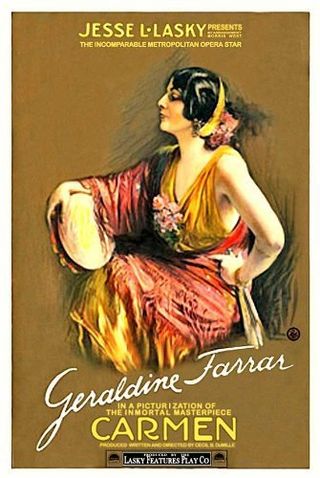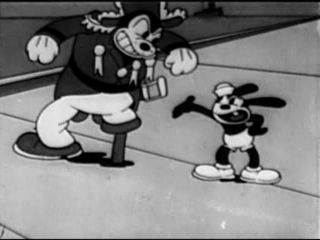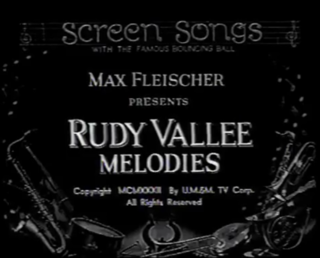
Oswald the Lucky Rabbit is an animated cartoon character created in 1927 by Walt Disney and Ub Iwerks for Universal Pictures. He starred in several animated short films released to theaters from 1927 to 1938. Twenty-seven animated Oswald shorts were produced at the Walt Disney Studio. After Universal took control of Oswald's character in 1928, Disney created a new character similar in appearance to Oswald as a replacement: Mickey Mouse, who went on to become one of the most famous cartoon characters in the world.

Walter Benjamin Lantz was an American cartoonist, animator, producer and director best known for founding Walter Lantz Productions and creating Woody Woodpecker.

King of Jazz is a 1930 American pre-Code color musical film starring Paul Whiteman and his orchestra. The film title refers to Whiteman's popular cultural appellation. At the time the film was made, "jazz", to the general public, meant jazz-influenced syncopated dance music heard on phonograph records, on radio broadcasts, and in dance halls. In the 1920s Whiteman signed and featured white jazz musicians including Joe Venuti and Eddie Lang, Bix Beiderbecke, Frank Trumbauer, and others.
Thomas Augustin Palmer was an Italian-American animator, cartoon director, and U.S. training film supervisor. He was active in the animation industry throughout the 1920s and 1930s and was best known for his animation work at Walt Disney Productions. He spent a good chunk of his later career directing training films for the United States Army.

Carmen is a 1915 American silent drama film directed by Cecil B. DeMille. The film is based on the novella Carmen by Prosper Mérimée. The existing versions of this film appear to be from the re-edited 1918 re-release.

El Terrible Toreador is a 1929 animated cartoon produced by Walt Disney Studios in the Silly Symphonies series. The short's copyright was renewed in 1957, so it will enter the US public domain on January 1, 2025.

The Navy is a 1930 short animated film produced by Walter Lantz and as part of the Oswald the Lucky Rabbit cartoons.

The Shriek is a 1933 animated short film produced by Walter Lantz Productions as part of the Oswald the Lucky Rabbit series. The cartoon's title is a parody of the 1921 Paramount film The Sheik.

Carnival Capers is a 1932 animated short film featuring Oswald the Lucky Rabbit. It is the 65th Oswald cartoon by Walter Lantz Productions and the 117th in the entire series.
Puppet Show is a 1936 short film from Walter Lantz Productions and stars Oswald the Lucky Rabbit. Unlike most shorts made by the studio, the film employs both animation and live-action.
Mexico is a 1930 short animated film by Walter Lantz Productions and stars Oswald the Lucky Rabbit. The soundtrack of the cartoon was missing for many years, until the discovery of a sound print in 2013. Then in 2014 the soundtrack version of the cartoon was uploaded to YouTube, but was deleted due to the YouTube account being terminated. In 2015 and 2016 two other youtubers uploaded the soundtrack version of the cartoon.

The Actor's Children is a 1910 American silent short drama written by Lloyd Lonergan and produced by the Thanhouser Company in New Rochelle, New York. The film features Orilla Smith, Yale Boss, Frank Hall Crane and Nicholas Jordan. The production was not the first film subject by the company, but it was the first to be released. Both Barry O'Neil and Lloyd B. Carleton have been credited as the director of the production. Edwin Thanhouser stated that 19 copies of the film were produced and distributed to dealers.
Radio Rhythm is a 1931 short animated film featuring Oswald the Lucky Rabbit. It is among the vast majority of Oswald cartoons produced by Walter Lantz Productions. It is the 45th Lantz Oswald cartoon and the 97th cartoon in total.

The Toy Shoppe is a 1934 short animated film produced by Walter Lantz Productions and is one of the many with the character Oswald the Lucky Rabbit. While the film was originally released in black and white, a colorized version was released in 1984.
Going to Blazes is a 1933 short animated film and one of many starring Oswald the Lucky Rabbit. The film is the 70th Oswald short by Walter Lantz Productions and the 122nd in the entire series.

The Cactus Kid is a Mickey Mouse short animated film first released on May 10, 1930, as part of the Mickey Mouse film series. It was the eighteenth Mickey Mouse short to be produced, the third of that year.

Rudy Vallee Melodies is a 1932 short film which is presented by Max Fleischer and was originally released by Paramount Pictures. The film, which features Betty Boop with a plethora of animals as she throws a house party in her house, stars Rudy Vallee as he sings three separate songs. The film also features sing-along versions to the songs that Vallee sings.

Permanent Wave is a 1929 animated film which is presented by Carl Laemmle and is produced by Walter Lantz. The film, which was written and animated by Walter Lantz, Bill Nolan and Tom Palmer, features Oswald the Lucky Rabbit rescuing a mermaid, whom he has fallen in love with, from his captain on the ship that Oswald is controlling during the film.

Hurdy Gurdy is a 1929 animated short film which is presented by Carl Laemmle and was produced by Walter Lantz, who he and his wife would go on to make Woody Woodpecker. The film, which is animated by R.C. Hamilton, Bill Nolan and Tom Palmer, features Oswald the Lucky Rabbit, who is substituted for the organ grinder's dancer, after the original one is comically swallowed up by Oswald's bubblegum.

Race Riot is a 1929 animated short film which is presented by Carl Laemmle and was produced by Walter Lantz, who would go on to produce and create the cartoon character Woody Woodpecker with his wife, Gracie Lantz. The film, which both its story and animation was composed by Walter Lantz, 'Bill' Nolan and Tom Palmer, features Oswald the Lucky Rabbit, as he attempts to win a horse race with his horse.
















